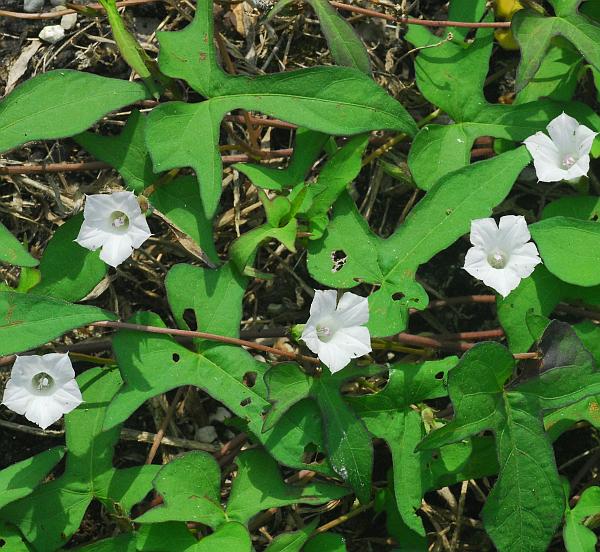Ipomoea lacunosa L.
Small White Morning Glory

Native
CC = 1
CW = 0
MOC = 82
© SRTurner
Ipomoea lacunosa L.Small White Morning Glory | |
 |
Native CC = 1 CW = 0 MOC = 82 |
© SRTurner |
|
Family - Convolvulaceae Habit - Taprooted annual forb. Stems - Vining, twining, sprawling, to 3 m, somewhat angled, glabrous or hairy.
Leaves - Alternate, petiolate. Petioles to 3 cm, sparsely hairy (sometimes in lines), with a shallow adaxial groove. Blades 2-8 cm long, unlobed or shallowly to deeply 3-lobed, the lobes triangular, broadly ovate to ovate-triangular in overall outline, tapered to a sharply pointed tip, shallowly to deeply cordate at the base, glabrous or both surfaces sparsely to moderately short-hairy, the margins otherwise entire.
Inflorescence - Flowers axillary, solitary or more commonly in loose clusters of 2-6, the stalks glabrous, minutely tuberculate, typically with a pair of opposite bracts in the apical third, these to 3 mm long, attenuate to subulate.
Flowers - Sepals 10-14 mm long, lanceolate to narrowly ovate, or narrowed or tapered to a sharply pointed tip, the margins sparsely to moderately pubescent with spreading hairs. Corollas 1.2-2.2 cm long, funnelform to slightly bell-shaped, glabrous, the tube widened gradually toward the tip, all white (for purple-flowered individuals, see the discussion of hybrids below). Stamens 5, not exserted. Filaments white, to 1 cm long, mostly glabrous but with thick pubescence at the base. Anthers pinkish-purple, 1.3 mm long. Ovary superior, conic, green, subtended by green nectariferous ring, usually 2-locular. Style white, glabrous, the stigma 2-lobed.
Fruits - Globose or slightly depressed-globose capsules, the main body 10-14 mm long, the persistent style 0.8-1.5 mm long, moderately to densely pubescent with relatively long, often curly, spreading hairs. Seeds 5-6 mm long, the surface glabrous.
Flowering - July - October. Habitat - Streambanks, pond margins, gravel bars, moist depressions of upland prairies, fens, crop fields, old fields, pastures, fencerows, ditches, railroads, roadsides, open disturbed areas. Origin - Native to the U.S. Lookalikes - None. Other info. - This little morning glory is common throughout most of Missouri, and occurs across most of the eastern half of the continental U.S. It is easily recgonized by its vining habit and small white flowers of the morning glory pattern. It can grow rapidly and is tolerant of disturbance. It is listed as a noxious weed in a few states, but in Missouri it appears to be reasonably well-behaved. Photographs taken in Brown Summit, NC., 9-8-02 (DETenaglia); also along the Bourbeuse River in Franklin County, MO, 8-21-2011, and along the Katy Trail near Dutzow, Warren County, MO, 8-13-2014, 9-4-2015, and 9-5-2021 (SRTurner). |